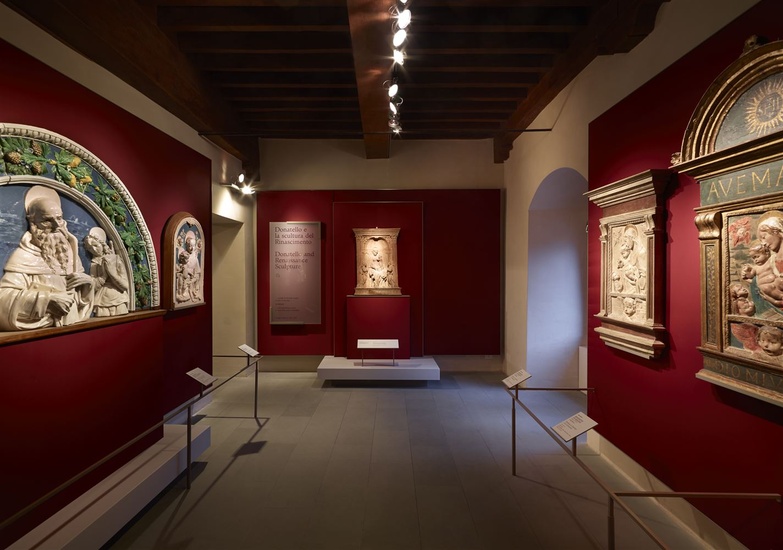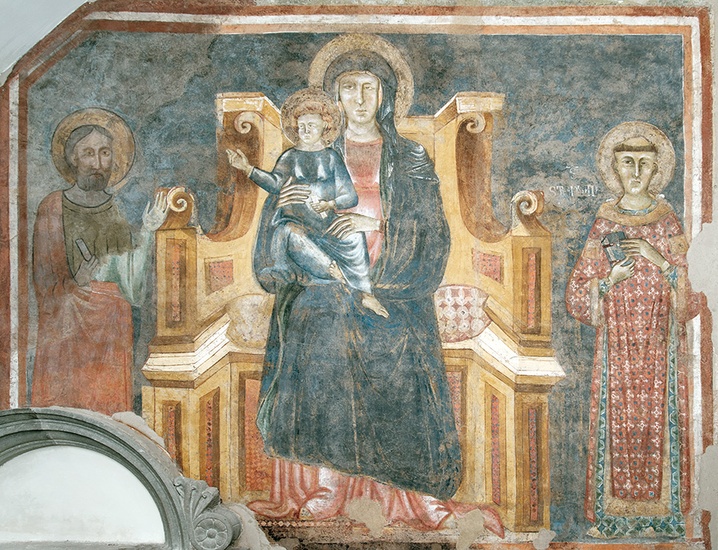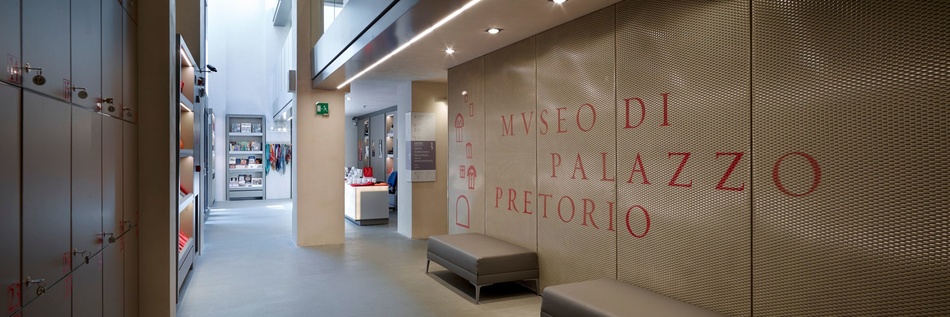The History of Palazzo Pretorio
Austere and imposing, Palazzo Pretorio has dominated Prato’s Piazza del Comune for more than eight hundred years acting as a silent witness to the political, civil and military history of the city. Today, its appearance evokes its long and troubled history through the changing architectural styles and continuous remodelling of its structure.
The Palace was built as a prison and seat of the municipal and foreign courts at the end of the thirteenth century. Its role radically changed in the eighteenth century, when the halls became administrative offices of the Grand Duchy of Tuscany, which required it to adapt to the needs of a modern state. In the mid-nineteenth century, the government offices moved out, and the Palace was left to decay, even being threatened with demolition. Fortunately, it was decided to embark on a long restoration that lasted until the early 1920’s, when the external stone staircase was rebuilt and the façade took its present shape. Meanwhile, in 1912, the new headquarters of the Museum were established in the halls of the Palazzo. The exposition increased over the years, occupying the entire building to form the Civic Museum.
In 2014, after important restorative measures started in 1998, the Museum reopened with the setting-up of the permanent collection, enriched by artworks from Prato and its territory. Its flexible and innovative layout both enhances the beauty of its halls and frescoes and the masterpieces of the city collections.
History History
The first documents about the palace date back to 1284, when Francesco de’ Frescobaldi, the Captain of the Guelph Mass, bought part of the Pipini towered building to establish it as the seat of the foreign courts run by the Magistrates, People’s Captain, Royal Vicar and Commissioner brought from outside the city, and of the municipal court and the prison. This original core dates back to the thirteenth-century brick tower house of the Pipini family that faced Piazza del Comune. Craftsmen from Florence expanded the palace between 1334 and 1338. In place of an old portion of the original structure, the current southern wing of the building was built in white limestone. This elegant crenelated structure, with its main, white façade facing east, is characterized by large mullioned windows and beamed, painted halls on the inside.
Later alterations partly modified the outer, medieval look. Some lancet windows - then reinstated - date back to the sixteenth century, as well as the sail of the clock, built in 1534 and designed by Nanni Unghero. The external staircase on the eastern aspect preserves a sixteenth century gallery of arches, while the ramps were renewed in the eighteenth century and restored ‘in style’ in the early twentieth century. In the fourteenth century a stone statue of Robert of Anjou (awarded with the city lordship) was placed in a niche above the access to the first floor. It was then destroyed at the end of the eighteenth century. From 1587 to the beginning of the eighteenth century, part of the ground floor was used as the seat of the Monte di Pietà (who have been present in Prato since 1476).
From the mid-eighteenth century, the palace housed government offices of the Grand Duchy of Tuscany, which were decentralized into larger and more modern structures during the nineteenth century. This led to the neglect of the palace that, by the end of the century, was in a poor condition. After being seriously considered for demolition, between 1890 and the early 1920’s a number of restoration projects were carried out. In conjunction with these works, the Municipal Gallery, formerly housed in the Palazzo del Comune, was established in 1912. A final, overall restoration was started in 1998 and ended in 2014, when the renovated Museo di Palazzo Pretorio has been reopened.
Interior decorations Interior decorations
Historical statements of its various functions, such as fine frescoes, coats of arms and commemorative stones, enrich the rooms of the Palazzo Pretorio. The halls of the first and the second floor are enchanting, while the third floor has a wonderful view overlooking the town.
Both on the internal and external walls of the Pretorio, one can admire the coats of arms sculpted or depicted through the ages concerning the Podestà, foreigner magistrates called to administer the City whose term of office lasted about six months.
On the ground floor there are two wide halls: one built in the 14th Century, with a groin vault abutted upon the main column; one built in the 16th Century, with the vaults decorated in a neo-Gothic style in the early 20th Century. Nearby, in two smaller rooms, there are two valuable frescoes: the first one was probably painted in 1307 by Bettino Corsino and depicts the Madonna with Child and the Saints John the Evangelist and Stephen, while the second one, painted in 1415 by Pietro and Antonio di Miniato, depicts Saints Stephen and John the Baptist presenting to Christ the City of Prato. This fresco offers a view of Prato with its historical buildings, such as the Palazzo Pretorio and the Palazzo Datini.
At the first floor there is a wide 14th Century hall, with a considerable number of coats of arms and an original ceiling constructed of painted wooden joists.
A statue of a Warrior with Shield from the 15th Century prevails over the room, in which a headless statue belonging to the Donatello school and a tondo of the Della Robbia school, bearing the Florentine People’s Coat of Arms, are also exhibited. A noteworthy fragment of Saint Frances, probably belonging to an early 14th Century Majesty, and a fine Annunciation made by Antonio da Miniato in the early 15th century, stand out among the pictorial decorations.
A noticeable fresco on the Crucifixion and a washbowl of stone of the 15th Century are displayed in the following rooms.
Walking up a stairway of the 16th Century and through the mezzanine, where one can admire a fresco credited to Tommaso di Piero, Christ in the Sepulcher , one reaches the second floor.
The wide hall has the original ceiling constructed of painted wooden joists and various coats of arms as on the first floor. There is also a 15th Century washbowl and a large fireplace. Of especial note are the three-lobed tabernacles, frescoed at the request of Podestà Alberto Salviati in 1382 by the Florentine painter Francesco di Michele with a Madonna with Child, the donor and the Saints Frances and Catherine from Alessandria.
There are many others valuable pictorial decorations, such as a Saint Christopher from the late 14th Century, a Madonna with Child and the angels from the middle 14th Century and a Saint Nicholas from the early 15th Century.
Recent Renovations Recent Renovations
The Civic Museum was closed in 1998 in order to carry out a complete restoration. The third floor of the Palazzo had already been shut since 1983, in order to replace the roof.
The story of the recent renovations gets under way in 1986, when Gae Aulenti and Bianca Ballestrero were given overall responsibility for an ambitious project not only comprising the Palazzo itself, but also all the adjacent buildings. For a number of reasons the project was significantly reshaped in the subsequent years; while, in 1998, in order to allow for the consolidation of the buildings, the Museum was closed and the collections left the building.
Works continued, despite various difficulties and challenges; finally in 2009, the project was reviewed by technical staff of the Municipality public works department, which led to various modifications being made, including, for example, bringing the main entrance back to the square.
With this last modification, the Palazzo internal decorations were brought back, including the beautiful ancient coat of arms of the podestà; the frescoes on the walls and the magnificent painted wooden ceilings, while the entire building was prepared for its new life of fruitfulness and conservation and made ready to welcome the renovated Museum thanks to the innovative project by the architects Guicciardini & Magni.
Are you intrigued? Visit us
Last update: 16 january 2025, 11:26


